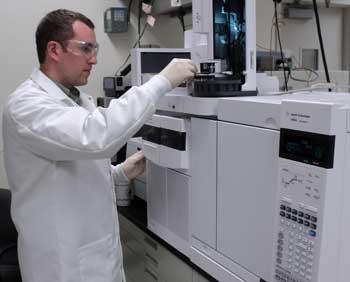
The world's most widely used and trusted resource for identifying mass spectra, the "fingerprints" of molecules, has undergone a major expansion, according to its managers at the National Institute of Standards and Technology (NIST). NIST 14, containing the newest edition of the NIST/EPA/NIH Mass Spectral Library, boasts significantly increased coverage within each of its three components: the NIST/EPA/NIH Mass Spectral Library of electron ionization (EI) spectra, the NIST Tandem Mass Spectral Library, and the NIST Library of GC Methods and Retention Index Data. These updated libraries were recently released to more than 30 distributors worldwide.

Mass spectrometry (MS) is routinely used to quickly and accurately identify chemical compounds for a wide range of applications such as drug detection, pollution monitoring, petrochemical processing and disease diagnosis via biomarkers. To use the method, a target molecule is first converted to an ionized gas. Fragmenting these ions into their components produces other ions whose intensities (abundances), when sorted according to mass and charge, produce a pattern known as a "mass spectrum." This spectrum serves as a fingerprint for identifying the target molecule. To ensure an accurate ID, the spectrum should be compared with a verified reference spectrum from a database such as the NIST/EPA/NIH Mass Spectral Library.
NIST 14 is made up of three databases and accompanying search software. The tool provides researchers with:
- EI (electron ionization) spectra, derived from traditional gas chromatography/mass spectrometry (GC/MS) methods;
- tandem mass (MS/MS) spectra, where the precursor (initial) ions formed in the mass spectrometer are fragmented in a separate step involving a second mass spectrometer (hence, the "tandem")—a common practice in liquid chromatography/mass spectrometry (LC/MS); and
- gas chromatography (GC) method/retention index data, which provide another means of confirming the identity of molecules.
Each spectrum in the new library has been critically examined by experienced mass spectrometrists at NIST and collaborating organizations, and each chemical structure has been scrutinized for correctness and consistency.
"This release provides one of the most significant enhancements in the long history of the Mass Spectral Library, with major increases in coverage for both the EI and tandem collections along with a higher level of organization of the data within them," says Stephen Stein, director of the NIST Mass Spectrometry Data Center and one of the researchers responsible for the development of NIST 14.
Among the other improvements to NIST 14 are a greatly expanded variety of precursor ions for tandem mass spectra; integration of retention index and mass spectral data; a new way to display the structures of molecular derivatives and the reagents that yield them; new search methods for high mass accuracy data; and the use of the International Chemical Identifier (InChI) standard for representing chemical structures (developed by NIST and the International Union of Pure and Applied Chemistry), which makes it easier to find additional information about molecular IDs made by the Mass Spectral Library.
For more information and a list of vendors offering NIST 14, go to www.nist.gov/srd/nist1a.cfm.

